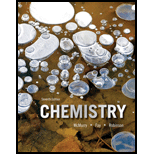
Concept explainers
Interpretation:
The freezing point of the given aqueous solution have to determine and should be arranged from lowest to highest freezing point: 0.10 m FeCl3, 0.30 m glucose (
Concept introduction: The solution of any solvent always have lower freezing point than that of the pure solvent. On cooling of a solution the solvent become separate due to formation of solid and the solute become insoluble in this condition. As the solute is non-volatile thus the vapour pressure over the solution in this condition is the vapour pressure of the solvent only. This vapour pressure always remain lower than that of pure solvent. When a liquid become solid due to decreases of temperature then there remain an equilibrium between the liquid state and solid state of the solvent. The liquid which has lower vapour pressure, need more low temperature for solidification. As the vapour pressure of the solvent in solution is always lower than the pure solvent, thus to solidify the solvent lower temperature is needed. For this condition scientist Raoult’s propose a law-In any solvent if a non-electrolyte, non-volatile solid solute is added then the depression of the freezing point of the solvent is proportional to the molal density of the solute in solution. Thus
Given:
The solutes i.e. FeCl3, C6H12O6 and CaCl2 are completely dissociated in the solution.
Want to see the full answer?
Check out a sample textbook solution
Chapter 12 Solutions
Chemistry (7th Edition)
 ChemistryChemistryISBN:9781305957404Author:Steven S. Zumdahl, Susan A. Zumdahl, Donald J. DeCostePublisher:Cengage Learning
ChemistryChemistryISBN:9781305957404Author:Steven S. Zumdahl, Susan A. Zumdahl, Donald J. DeCostePublisher:Cengage Learning ChemistryChemistryISBN:9781259911156Author:Raymond Chang Dr., Jason Overby ProfessorPublisher:McGraw-Hill Education
ChemistryChemistryISBN:9781259911156Author:Raymond Chang Dr., Jason Overby ProfessorPublisher:McGraw-Hill Education Principles of Instrumental AnalysisChemistryISBN:9781305577213Author:Douglas A. Skoog, F. James Holler, Stanley R. CrouchPublisher:Cengage Learning
Principles of Instrumental AnalysisChemistryISBN:9781305577213Author:Douglas A. Skoog, F. James Holler, Stanley R. CrouchPublisher:Cengage Learning Organic ChemistryChemistryISBN:9780078021558Author:Janice Gorzynski Smith Dr.Publisher:McGraw-Hill Education
Organic ChemistryChemistryISBN:9780078021558Author:Janice Gorzynski Smith Dr.Publisher:McGraw-Hill Education Chemistry: Principles and ReactionsChemistryISBN:9781305079373Author:William L. Masterton, Cecile N. HurleyPublisher:Cengage Learning
Chemistry: Principles and ReactionsChemistryISBN:9781305079373Author:William L. Masterton, Cecile N. HurleyPublisher:Cengage Learning Elementary Principles of Chemical Processes, Bind...ChemistryISBN:9781118431221Author:Richard M. Felder, Ronald W. Rousseau, Lisa G. BullardPublisher:WILEY
Elementary Principles of Chemical Processes, Bind...ChemistryISBN:9781118431221Author:Richard M. Felder, Ronald W. Rousseau, Lisa G. BullardPublisher:WILEY





